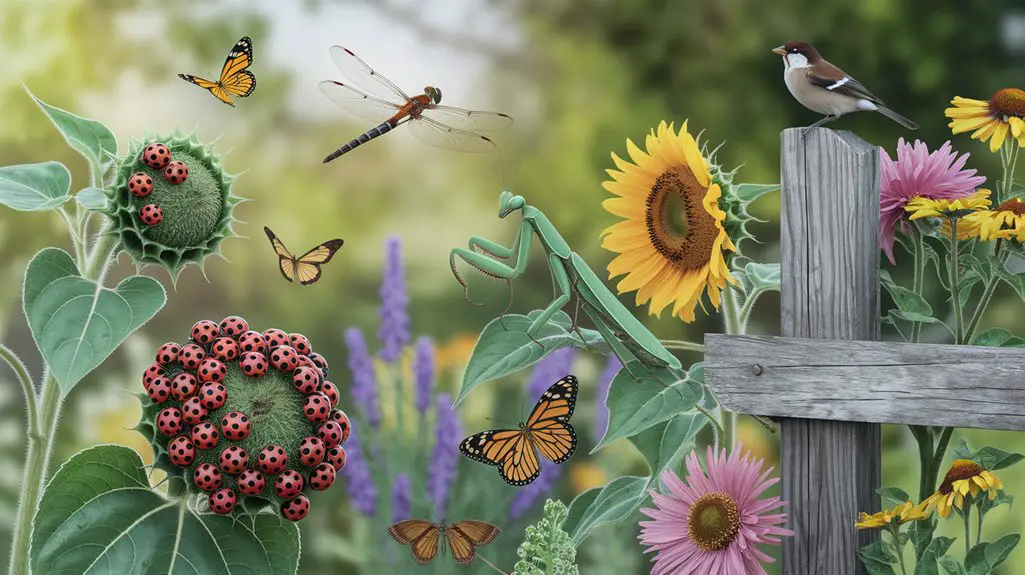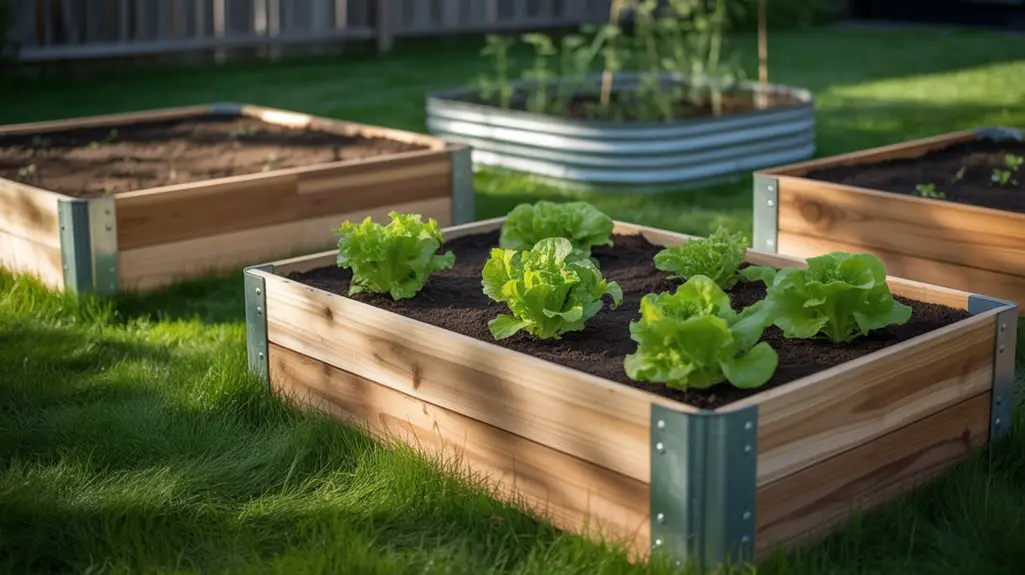Imagine walking out to your garden to find your tomato plants utterly devastated by hornworms overnight. You’re not alone in this frustrating battle against garden pests. While conventional pesticides offer quick fixes, they’ll introduce harmful chemicals into your ecosystem and potentially harm beneficial insects. Natural pest control techniques provide effective alternatives that work with nature’s systems rather than against them. You’ll discover how to transform your garden into a balanced ecosystem where pests no longer dominate.
Beneficial Insects: Your Garden’s Natural Defenders
Ladybugs, praying mantises, and lacewings represent nature’s elite defense force against destructive pests. These predatory insects target aphids, mites, and caterpillars that damage your plants. A single ladybug can consume up to 5,000 aphids during its lifetime, providing concentrated pest management without chemicals.
To attract these beneficial allies, you’ll need to create hospitable environments. Plant diverse flowering species like yarrow, dill, and alyssum to provide nectar and pollen. Avoid broad-spectrum insecticides that eliminate both harmful and beneficial insects indiscriminately.
You can purchase beneficial insects from garden suppliers, but proper release timing is essential. Deploy ladybugs at dusk after watering your garden to encourage them to stay. Additionally, incorporating organic pest control methods can further enhance your garden’s health and resilience.
Maintain undisturbed areas with leaf litter and perennial plants as overwinter habitat.
Companion Planting Strategies to Deter Pests

While chemicals and beneficial insects offer reactive solutions, companion planting provides a proactive approach to pest management through strategic plant combinations. You’ll find that certain plants naturally repel specific pests or confuse them by masking host plant scents. Additionally, natural pest control methods can enhance the effectiveness of these companion plantings.
| Plant Combination | Target Pest |
|---|---|
| Tomatoes + Basil | Hornworms, aphids |
| Carrots + Onions | Carrot flies |
| Cucumbers + Nasturtiums | Cucumber beetles |
| Cabbage + Thyme | Cabbage worms |
Implement these pairings by interspersing companion plants throughout your garden rather than segregating them. For maximum effectiveness, maintain proper spacing to prevent competition for nutrients while ensuring their protective compounds can interact. You’ll need to replant annual companions each season, while perennial companions provide ongoing protection.
Homemade Organic Sprays and Solutions

When commercial pesticides threaten beneficial organisms and introduce chemicals to your ecosystem, homemade organic sprays offer targeted pest control without harmful residues.
These solutions utilize common household ingredients while delivering effective results against specific pests.
A mixture of one tablespoon neem oil, one teaspoon liquid castile soap, and one liter of water creates a potent spray that disrupts insect hormonal systems.
For fungal issues, combine one part milk with nine parts water to combat powdery mildew on cucurbits and roses.
You’ll find garlic-pepper spray (five garlic cloves, two tablespoons hot pepper flakes steeped in water overnight) particularly effective against soft-bodied insects. Harnessing Garlic Spray can enhance your pest control strategy by utilizing the natural properties of garlic.
Apply your DIY solutions during early morning or evening to maximize efficacy and prevent leaf burn.
Always test new sprays on small plant sections before widespread application.
Physical Barriers and Traps for Pest Management
Physical barriers and traps represent fundamental mechanical defenses that interrupt pest life cycles without chemical interventions. You’ll find row covers, netting, and mesh particularly effective at excluding flying insects while allowing light and water penetration.
Install copper tape around vulnerable plants to repel slugs and snails through mild electrical deterrence.
Strategic trap deployment enhances your integrated pest management approach. Consider sticky traps for whiteflies and aphids, pheromone traps for moths, and pitfall traps for ground-dwelling pests. For larger pests, diatomaceous earth creates microscopic cutting barriers that dehydrate insects upon contact.
When installing barriers, guarantee complete coverage without gaps. Position traps at pest entry points or near susceptible crops.
Remember to monitor and maintain these physical controls regularly, as their effectiveness diminishes with weather exposure and accumulation of captured pests. Additionally, using natural pest management practices in conjunction with these methods can lead to a more sustainable gardening approach.
Maintaining Healthy Soil to Prevent Pest Problems
Healthy soil serves as the foundation of effective natural pest management, creating resilient plants with enhanced immune responses to potential threats.
You’ll need to maintain ideal soil pH (6.0-7.0) and integrate organic matter through regular compost applications to foster beneficial microorganisms that suppress pathogens.
Implement crop rotation strategies to disrupt pest cycles and prevent nutrient depletion.
Mulching with organic materials conserves moisture, regulates soil temperature, and creates habitat for beneficial organisms like ground beetles and earthworms.
Additionally, avoid excessive tilling, which disrupts soil structure and beneficial fungal networks.
Regular soil testing enables targeted amendments with specific minerals and nutrients your garden lacks.
Remember that well-nourished plants naturally produce stronger cell walls and chemical defenses, making them less susceptible to pest invasion and requiring fewer interventions throughout the growing season.
Moreover, fostering beneficial microorganisms in your soil can enhance plant health and contribute to a more robust ecosystem that deters pests naturally.
Conclusion
You’ll find natural pest control transforms your garden ecosystem while eliminating chemical dependencies. Research shows gardens using integrated pest management techniques experience up to 85% reduction in harmful pest populations within a single growing season. By implementing these five strategic approaches—beneficial insects, companion planting, organic sprays, physical barriers, and soil management—you’re establishing a sustainable defense system that works continuously to protect your investment with precision and minimal intervention.




